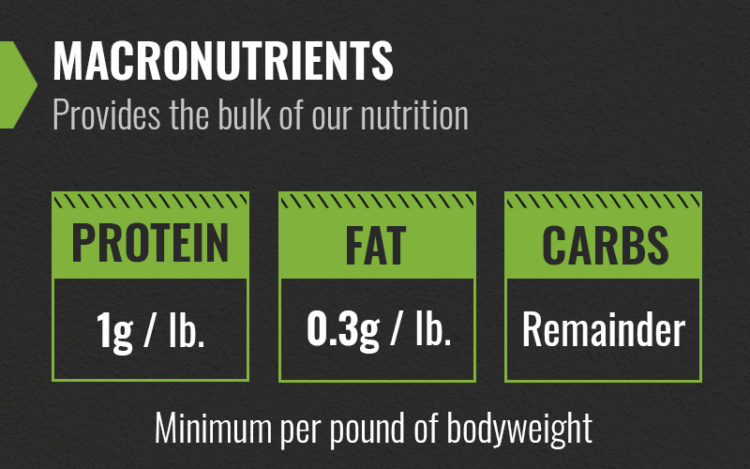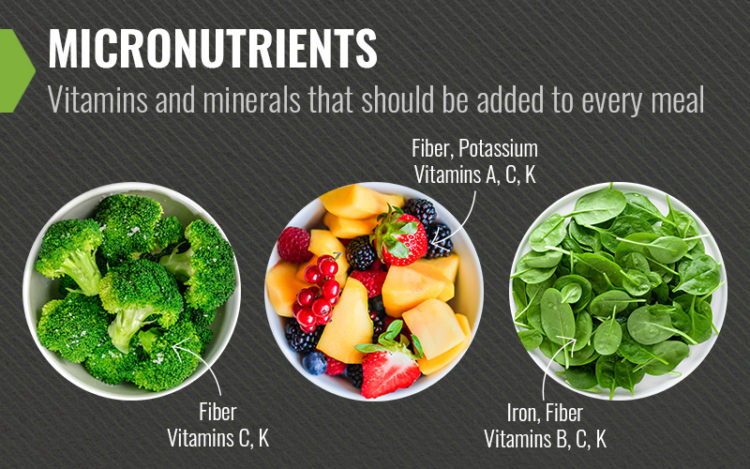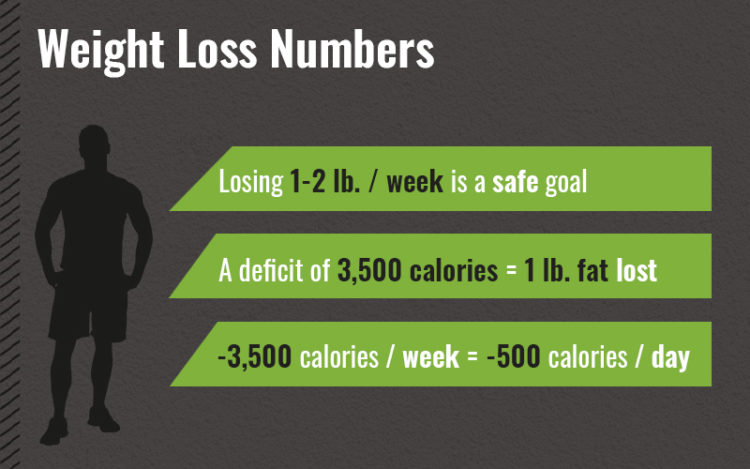Proper nutrition goes beyond just counting calories. Whether you want to build muscle, lose fat, or push your performance in the weight room, the quality and composition of what you eat matters just as much as how many calories you put down daily.
Your macronutrient distribution — that’s dietary protein, fat, and carbohydrate — plays a significant role in how your body changes over time. Too much of one or too few of another can result in losing muscle when you want to shed fat (or vice-versa).
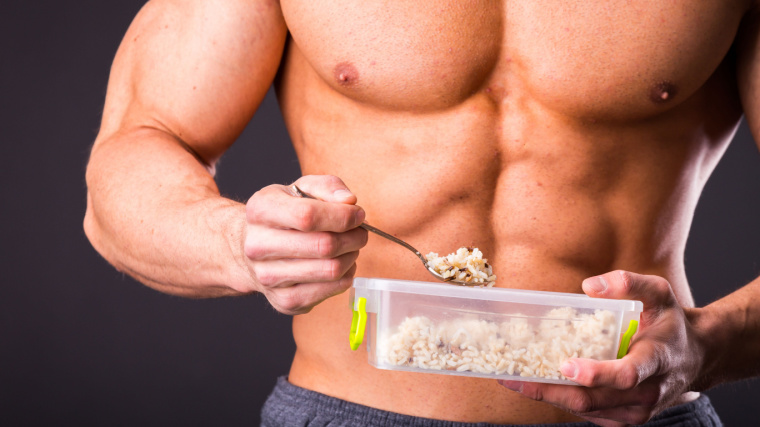
To ensure that you’re making the right strides in the gym and on the scale, you need to know how to balance your protein, carbohydrate, and fat intakes alongside the number of calories you eat. You need a macronutrient calculator; a damn good one.
Editor’s Note: The content on BarBend is meant to be informative in nature, but it shouldn’t take the place of advice and/or supervision from a medical professional. The opinions and articles on this site are not intended for use as diagnosis, prevention, and/or treatment of health problems. Speak with your physician if you have any concerns.
Best Macronutrient Calculator
This calculator uses several formulas to come up with guidelines — and there are guidelines — for how to structure your calorie intake. By submitting some basic information about your body and your activity habits, you’ll come away with a reliable starting point that can help you make the changes you’re after.
Macronutrient Calculator
How It Works
Metabolic calculators like this one simply take the math out of your hands. Our macro calculator is based upon a combination of factors, principally, how much you weigh and how many calories you’re likely to burn on a daily basis. Once you know how much energy you expend, you can begin to determine how to fuel yourself.
Your Basal Metabolic Rate (BMR)
Your basal metabolic rate, or BMR, is the number of calories your body requires to fuel its most essential and non-locomotive functions. It’s how much energy you burn simply by existing; digesting food, moving blood and nutrients around, stuff like that.
Everyone’s BMR is different and is partly determined by non-controllable factors like genetics. Larger individuals with higher body weights tend to have higher BMRs as well.
Your Total Daily Energy Expenditure (TDEE)
You probably do more than lie idle in bed all day, so you’ll need to account for your physical activity as well. Your total daily energy expenditure, or TDEE, refers to your BMR plus all the calories you burn through physical movement (including dedicated exercise).

Some wearable devices can help you assess your TDEE in real time, but no piece of tech is 100-percent accurate. You may get a better reading than what a calculator can provide, but you’ll have to go through some trial and error all the same.
The Thermic Effect of Food (TEF)
The energy you spend digesting the foods you eat also costs calories. This is known as the thermic effect of food (TEF). In some cases, your TEF can account for as much as 10 percent of your TDEE. It’s not something you should necessarily worry about or pay attention to, but it’s worth mentioning.
Large meals that contain lots of protein and carbohydrates tend to have higher TEFs than small snacks or fatty foods. There’s also a small bump in energy cost if you consume a lot of cold food items; even chilled drinks take a scant amount of energy to heat up as they’re digested.
Your Macronutrients (Macros)
Each gram of protein, carbohydrate, or fat contains calories. So, any distribution of macronutrients will contain a certain number of calories as well. Protein and fat have minimum thresholds that you have to hit; they are essential for certain bodily functions and general health.
Carbohydrates aren’t required to survive (but they’re great for athletic performance), so you can use them to “fill in” your remaining calories once you’ve determined your protein and fat needs.
Here are the minimum amounts of protein, carbs, and fat you should aim for, no matter how you want to adjust your body composition. These values are flexible depending on your goals, but this is the long and short of it:
- Protein: 1 gram per pound of body weight.
- Fat: 0.3-0.4 grams per pound of body weight.
- Carbs: As many as you’d like to fill in your remaining calories.
Protein — 4 Calories per Gram
The American Dietetic Association, Dietitians of Canada, and the American College of Sports Medicine, The International Association of Athletics Federations have all stated that a minimum of 0.7 grams of protein per pound of bodyweight is sufficient for gaining muscle or losing fat. (1)(2)
On average, athletes tend to shoot for 1 gram per pound — it’s easier to remember, has no deleterious effects, and it matters less if you happen to fall a little short, so that’s the number our calculator lands on. Know that you if you don’t quite hit this goal or you go a little over, it’ll make no practical difference.
Folks with a lot of muscle mass who are trying to retain as much as possible during weight loss may benefit from slightly higher protein intakes, up to 1.4 grams per pound, according to some limited research on bodybuilders. (3)(4)
Fat — 9 Calories per Gram
Diets too low in fat intake can sometimes cause a host of health problems, including suppressed hormonal function and low testosterone. (5)(6)(7) You should aim for at least 0.3 grams of fat per pound of body weight; our calculator ensures you clear that threshold when in a caloric deficit. It also provides a bit more leeway if you’re eating more, to allow for more flexibility in food source selection.
Carbs — 4 Calories per Gram
Carbohydrates are your body’s preferred fuel source for most forms of physical activity, as they are more efficiently converted into energy than fat or protein. That said, you don’t strictly require them to function.
As such, you should address your carbohydrate intake after you’ve determined your protein and fat needs: Say you need 150 grams of protein and 60 grams of fat. They each contain four and nine calories. In hitting those numbers, you’ll naturally consume 1,140 calories.
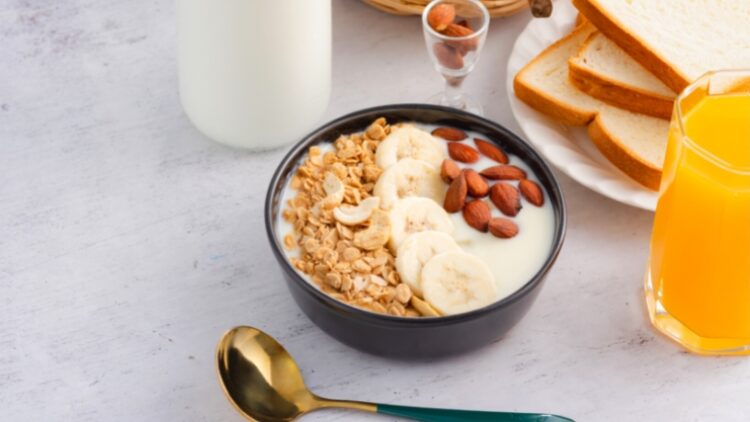
If your target caloric intake is 2,000 calories, that would leave you with 860 calories to allocate toward carbs if you wish (or, you could add more protein or fat if you prefer the way those foods taste). If you dedicated all of your remaining 860 calories to carbs, you’d end up with 215 grams of carbs in total.
What Are Macronutrients?
(Almost) all the foods you eat have nutritional value, whether large or small. Macronutrients are designated as such because they have a measurable caloric content and directly stimulate active processes like muscle tissue repair (aka muscle recovery) and energy synthesis.
As a note, alcohol (like beer) does have a caloric value (seven per gram) but your body cannot metabolize it the same way you’d process carbs or fat. You can certainly count your calories from alcohol, but perhaps not toward your carbohydrate quota.
Protein
Protein’s primary benefit is that it helps to build tissue, like muscle. The ideal protein intake is still hotly debated in some nutrition circles, but it’s generally understood that if one’s goal is to build or retain muscle while minimizing fat gain, one should exceed the FDA’s recommended daily intake of 50 grams, which is what’s advised to avoid a deficiency. Most sporting bodies recommend a minimum of 0.7 grams per pound of bodyweight; 105 grams for a 150-pound person.
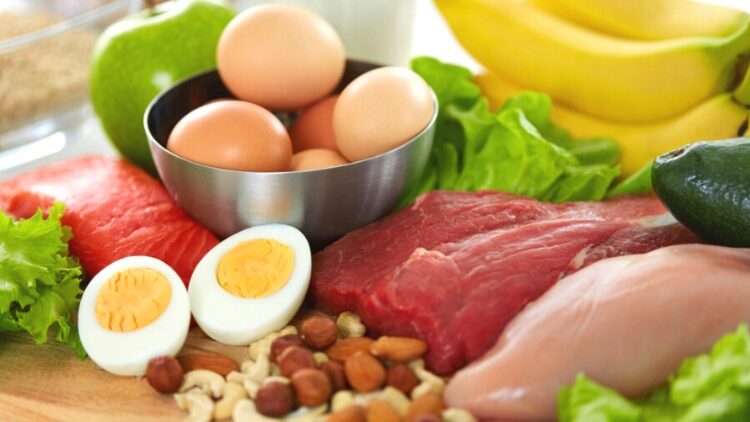
Protein also has an unusually high thermic effect, meaning that metabolizing it burns more calories than other macronutrients. Evidence suggests some 20 to 30 percent of protein’s calories are burned just processing it, with carbs at five to 10 percent and fat at zero to three percent. (8)
This, in addition to its high level of satiety, is another reason why high-protein diets are often recommended for weight loss. Protein has 4 calories per gram.
Carbohydrates
A biomolecule comprised of carbon, hydrogen, and oxygen, carbohydrate (or “carbs”) are the body’s main source of fuel. They usually fall into the category of starch or sugar and come in the forms of fructose, glucose, lactose (found in dairy), among others. Carbs are not strictly essential for human function; some food plans, like the ketogenic diet, intentionally eschew them in favor of converting protein and fat into energy.
Carbohydrates contain 4 calories per gram. The extent to which fiber contributes calories is unclear. Some opt to count calories from fiber, others don’t. Experiment and find what works best for you.
[Read: Best Carb Supplements]
Fiber
Fiber is a type of carbohydrate, but it’s not fully digested by the body and isn’t an especially efficient source of energy. Fiber is nonetheless an essential nutrient, helping to reduce inflammation, promote laxation, maintain a healthy population of gut bacteria (which help with nutrient absorption), improve heart health, minimize blood sugar spikes, and a host of other benefits.
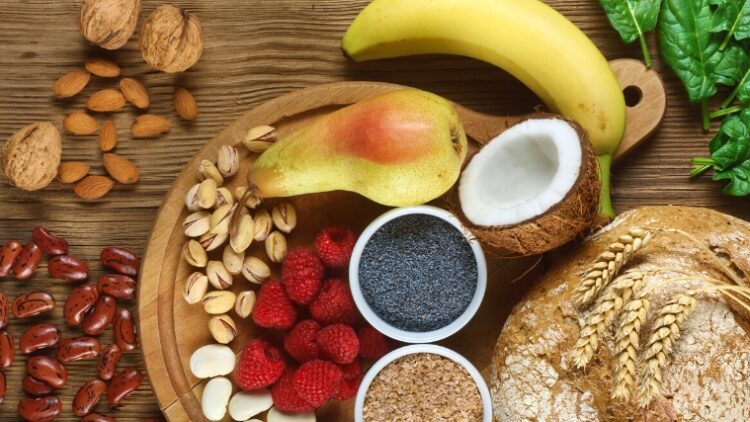
Since dietary fiber slows down and regulates digestion, you may want to avoid high-fiber carb sources in close proximity to your workouts if you want immediate energy.
Fat
At nine calories per gram, fat is by far the most calorically-dense macronutrient. It’s also very easy to overserve — “eyeballing” a lug of olive oil can easily result in two or three hundred extra calories in a dish.
Ignoring the persistently untrue narrative that “eating fat makes you fat,” you should understand that dietary fat is crucial as a regulatory agent. Fat helps maintain proper hormonal function and aids in nutrient partitioning, particularly for micronutrients like Vitamins A and D.
Types of Fats
Fats come in a wide variety of forms and are commonly split into “saturated” and “unsaturated,” but within those categories are smaller sub-categorizations such as polyunsaturated (omega-3) fats.
Regardless, all dietary fats contain the same number of calories per gram. All forms of dietary fat are perfectly fine to ingest in moderation, with the exception of trans fats, which you should take care to avoid when possible.
How to Track Your Macros
Once you know how many of each macro you need, your next step is figuring out how to keep track of it all. This isn’t as daunting as you might think, and should become quite intuitive over time if you commit to it.
Here are a few of your options for effectively tracking your macros.
Nutrition Apps
There are a whole host of fitness and nutrition apps that can do the arithmetic for you and keep tabs on your macros. Apps like MyFitnessPal or MacroFactor can even read nutrition labels on food packaging and input the data automatically (if you don’t want to enter it manually).
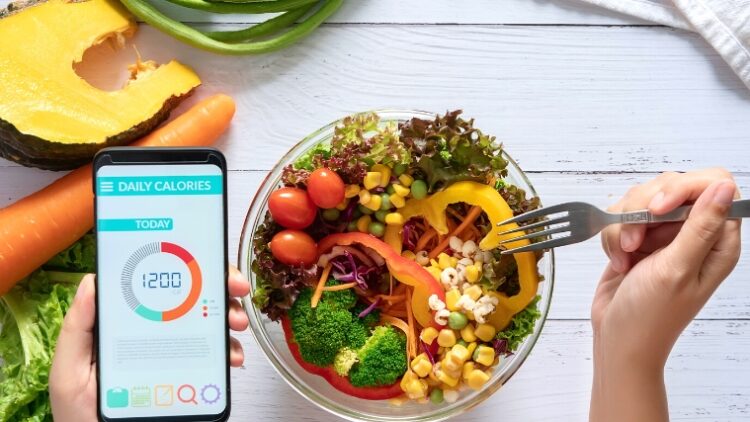
Most food logging apps also create and maintain a food library. If you like to prep tasty dishes from scratch that don’t come with a singular nutrition label, you only need to do the math yourself once. Input the total macronutrient content into the library and it’s plug-and-play from then on.
Pen and Paper
Some nutrition apps can have obtrusive or intricate interfaces. If you’re the old-fashioned type, you can track your macros manually by simply writing down the nutritional content of whatever you eat.
This method is great if you don’t have use for any of the auxiliary services most apps provide (or if an app is gated behind a paywall). To accurately track macros manually, strongly consider picking up a food scale.

Food scales allow you to accurately measure portion sizes. Eight ounces of orange juice(one standard serving) won’t always line up with a full cup, for example, so your best bet is to weigh out accurate portions on the scale. Once the value on the scale matches the prescribed portion size on the nutrition label (usually in grams), you’re in business.
The Hand Method
You might find it easier to measure visually with your hands: figure out the macros of a “palm” of protein, “four fingers” of carbs and a “thumb” of fat (these benchmarks usually equate to one standard serving).
Macro tracking can be daunting, but it’s a skill that’s worth cultivating — even measuring visually can be inconvenient at first, but it’s simply the most effective way to change your weight and body composition. (9) Once you’ve measured your intake religiously for a few weeks, it’ll be much easier to get a feel for how much you’ve eaten, and you may be able to ditch the apps and scale altogether.
Eyeballing portion sizes works well if you consume a lot of single-food items (as in, plain rice or unseasoned chicken), but loses value if you cook with a lot of different ingredients or eat out on a regular basis.
You may also want to steer clear of this method if you’re meticulously prepping for a bodybuilding show or need to make a specific body weight for a strength competition. In these situations, every single calorie matters.
Macronutrients vs Micronutrients
Understanding the differences between macronutrients and micronutrients can save you time and stress down the road. Here’s how they differ and why they’re both equally important.
Macronutrients
Macronutrients are defined primarily by the fact that they come with a caloric content. Their energy density (four calories per gram of protein and carbs, and nine for each gram of fat) distinguishes them as a fuel source, in addition to their other roles in your body. Macronutrients are commonly measured in grams.
Micronutrients
On the other hand, micronutrients do not contain measurable caloric values. These are your vitamins and minerals; Vitamin C, iron, zinc, B-vitamins, calcium, and much more.
Note that there’s some discrepancy in the nomenclature. For instance, the United Nations’ Food and Agriculture Organization considers them macrominerals rather than macronutrients. For practicality’s sake, most dietitians regard vitamins and minerals as micronutrients.
Micronutrients may not contain calories, but they are essential for healthy bodily function. “Junk food” may contain hearty amounts of carbs and fat (and plenty of calories to boot), but are often scant on the micronutrients you need.
Whole food sources are ideal for micronutrient consumption. Make sure you include plenty of fruits, vegetables, whole grains, and other nutritionally-dense options.
Macros for Weight Loss
If you’re invested in counting macros for the purposes of weight loss, you should take care regarding how fast you’re aiming to shed pounds. Undercutting your nutrition may move the number on the scale quickly, but losing weight too rapidly can create negative health outcomes like gallstones, constipation, fatigue, headaches, and other issues. (10)(11)(12)
Broadly speaking, nailing down a 500-calorie daily caloric deficit over the course of a seven-day week will result in one pound of body weight lost. Going a little steeper is generally fine, but losing more than two pounds per week may put your health at risk.
However, you don’t strictly need to maintain the same exact caloric deficit every day. If you eat one or two hundred extra calories on a given day, you can steepen your deficit the next day without it impacting your overall progress.
So long as your total calories for the end of the week are 3,500 less than you burned, it doesn’t appear to make too much of a difference how it shakes out on a daily basis. (13)
Macros for Bodybuilding
Increasing your body weight through muscle gain is a substantially more difficult and time-intensive process than shedding a few pounds of spare fat. If you’re brand new to weight training, mass gains often flow like water, and you may even see the scale move up as you add muscle without tracking your nutrition at all.
Late in the game, though, you’ll need to pay close attention to your caloric surplus, the composition of your macronutrients, and how hard you’re hitting the weights, of course. Growing new muscle is metabolically demanding; don’t expect to add a pound of lean mass every week if you’ve been training for several years already.
Your best bet is to calculate your macros in the context of a conservative (say, 200-300 extra calories) surplus and be very patient.
That’s general advice. Some more precise advice, given by Dr. Eric Trexler of Stronger By Science, is to aim to gain 0.25 to 0.5 percent of your bodyweight each week. If you weigh 200 pounds, that’s 0.5 to 1 pound per week. Starting conservatively and adding calories over time if the scale isn’t moving at all is a solid strategy for staving off any potentially-unwanted fat gain.
Carb Cycling
Some athletes find it more beneficial to eat more carbs and more calories on workout days and more fat and fewer calories on rest days.
As long as your total weekly nutritional intake aligns with your calorie and macro goals, cycling your macros on workout or rest days is a fine strategy. Some evidence suggests it may be more effective than a consistent intake. (14)(15) It also may be beneficial for improving insulin sensitivity, which refers to how effectively your body processes energy. (16)(17)(18)(19)(20)
Remember that total calories and macros are far more important when it comes to managing weight, body composition, and performance, and the precise timing is not a priority. But if you’re happy to put in the extra work, carb cycling usually looks like this:
Sample Fat Loss Program
Goal: 3,500-4,000 calorie deficit per week
Maintenance calories (TDEE): 3,000
- Monday (workout day): 3,000
- Tuesday (rest day): 2,000
- Wednesday (workout day): 3,000
- Thursday (rest day): 2,000
- Friday (workout day): 3,000
- Saturday (rest day): 2,000
- Sunday (rest day): 2,000
Total deficit for the week: 4,000 calories
Note that the deficit is still the same, but eating at maintenance on workout days and increasing the deficit on rest days from 500 to 1,000 may help with performance. Again, this is entirely optional and it’s a small factor in your overall success.
Food Sources for Macros
Almost every food contains some protein and some fat and, with a few exceptions (like meat and eggs), some carbs. Prioritizing single-food items and avoiding pre-prepared or frozen meals can make it more convenient to track your macros, but it isn’t mandatory.
Note that plenty of foods are good sources of more than one macronutrient: Beans provide protein and carbs, and milk contains all three of them.
Best Protein Sources
To get heaps of high-quality, complete protein in, you’ll generally have to indulge in meat, fish, or poultry. These foods are very protein-dense and are generally affordable. However, if you practice vegetarianism or veganism, you certainly have other options:
- Lean beef
- Chicken
- Lean pork
- Fish
- Firm tofu`
- Tempeh
- Egg whites
Best Fat Sources
Steaks and bacon are all well and good, but you should broaden your options and look beyond animal fats to meet your dietary fat needs:
- Nuts
- Coconut
- Oils
- Avocado
- Olives
- Dark chocolate
- Salmon
Best Carb Sources
Carbs are easy to come by, whether you prefer to eat starchy foods like rice or pasta or want to go green and enjoy more hearty veggies. Try these whole-food options and branch out from there:
- Fruit
- Rice
- Bread
- Starchy vegetables
- Popcorn
- Pasta
- Quinoa
Best Protein and Carb Sources
These foods contain roughly one gram of protein for every two to four grams of carbs. Legumes are a particularly good way to get both of these macros: 2 cups of lentils, for instance, provides 36 grams of protein, 80 grams of carbs, 32 grams of fiber, and less than two grams of fat.
- Beans
- Bread
- Sprouted grains
- Skim milk
- Peas
- Oatmeal
Best Protein and Fat Sources
The combination of fat and protein helps to really slow digestion, making these foods a good source of calories that will help you feel full as well:
- Whole eggs
- Beef
- Bacon
- Salmon
- Chia seeds
- Cheese
- Whole yogurt
Best Carb and Fat Sources
It isn’t wise or efficient to base entire meals around only carbs and fat at the expense of protein. Typically, that’s the nutritional profile you’d find in junk foods, and even if you’re eating a combination of whole foods with these macros — say, a rice pudding with coconut oil in it — these meals are rarely filling.
What’s more, leaving protein out of one or more meals may make it difficult to hit your protein target at the end of the day and limit your possibilities. Still, here are some indulgent options that are heavy on carbs and fat:
- Ice cream
- Cookies
- Cake
- Donuts
- Fries
- Granola
Your Takeaways
Paying attention to the composition of nutrients in your diet can help you better achieve your goals. Within any caloric target lies a certain proportion of macronutrients as well. Properly balancing them is essential to building muscle, losing fat, and performing optimally.
- Tracking macros and counting calories are two halves of the same process.
- Macronutrients are defined by their caloric content, so eating a certain number of protein, carbs, and fat will equate to a consistent number of total calories.
- Protein and carbohydrate each contain four calories per gram; fat has nine.
- You need a specific amount of protein and fat to function on a day-to-day basis, but your carbohydrate intake can be flexible depending on your preferences or athletic demands.
- A good calculator can help you determine how many of each macro you need. Then, keep tabs on it with a nutrition app, pen and paper, or eyeballing portion sizes.
The Macro Factor
Once you arm yourself with an evidence-based, easy-to-use macronutrient calculator, you’re well on your way to taking control over your diet and improving your physique or performance. Nutritional tracking may seem daunting at first, but you now have all the information you need at your fingertips.
Remember that making any kind of dietary change should be a gradual process that you grow into, rather than a switch you flip. Sustainability is key here, and above all, speak with your physician before making any drastic adjustments to your eating habits.
Oh, and for goodness’ sakes, don’t forget your micronutrients.
References
- 1. Rodriguez NR, et al. Position of the American Dietetic Association, Dietitians of Canada, and the American College of Sports Medicine: Nutrition and athletic performance. J Am Diet Assoc. 2009 Mar;109(3):509-27.
2. Burke LM, et al. International Association of Athletics Federations Consensus Statement 2019: Nutrition for Athletics. Int J Sport Nutr Exerc Metab. 2019 Mar 1;29(2):73-84.
3. Helms ER, et al. Evidence-based recommendations for natural bodybuilding contest preparation: nutrition and supplementation. J Int Soc Sports Nutr. 2014 May 12;11:20.
4. Longland TM, et al. Higher compared with lower dietary protein during an energy deficit combined with intense exercise promotes greater lean mass gain and fat mass loss: a randomized trial. Am J Clin Nutr. 2016 Mar;103(3):738-46.
5. Dorgan JF, et al. Effects of dietary fat and fiber on plasma and urine androgens and estrogens in men: a controlled feeding study. Am J Clin Nutr. 1996 Dec;64(6):850-5.
6. MInguez-Alarcón L, et al. Fatty acid intake in relation to reproductive hormones and testicular volume among young healthy men. Asian J Androl. 2017 Mar-Apr;19(2):184-190.
7. Mumford SL, et al. Dietary fat intake and reproductive hormone concentrations and ovulation in regularly menstruating women. Am J Clin Nutr. 2016 Mar;103(3):868-77.
8. Westerterp KR, et al. Diet induced thermogenesis. Nutr Metab (Lond). 2004 Aug 18;1(1):5.
9. Ingels JS, et al. The Effect of Adherence to Dietary Tracking on Weight Loss: Using HLM to Model Weight Loss over Time. J Diabetes Res. 2017;2017:6951495.
10. Johansson K, et al. Risk of symptomatic gallstones and cholecystectomy after a very-low-calorie diet or low-calorie diet in a commercial weight loss program: 1-year matched cohort study. Int J Obes (Lond). 2014 Feb;38(2):279-84.
11. Vink RG, et al. The effect of rate of weight loss on long-term weight regain in adults with overweight and obesity. Obesity (Silver Spring). 2016 Feb;24(2):321-7.
12. Christensen P, et al. Comparison of a low-energy diet and a very low-energy diet in sedentary obese individuals: a pragmatic randomized controlled trial. Clin Obes. 2011 Feb;1(1):31-40.
13. Catenacci VA, et al. A randomized pilot study comparing zero-calorie alternate-day fasting to daily caloric restriction in adults with obesity. Obesity (Silver Spring). 2016 Sep;24(9):1874-83.
14. Coyle EF, et al. Timing and method of increased carbohydrate intake to cope with heavy training, competition and recovery. J Sports Sci. 1991 Summer;9 Spec No:29-51; discussion 51-2.
15. McConell G, et al. Effect of timing of carbohydrate ingestion on endurance exercise performance. Med Sci Sports Exerc. 1996 Oct;28(10):1300-4.
16. Balkau B, et al. Physical activity and insulin sensitivity: the RISC study. Diabetes. 2008 Oct;57(10):2613-8.
17. Nelson RK, et al. Daily physical activity predicts degree of insulin resistance: a cross-sectional observational study using the 2003-2004 National Health and Nutrition Examination Survey. Int J Behav Nutr Phys Act. 2013 Jan 28;10:10.
18. Keane KN, et al. Molecular Events Linking Oxidative Stress and Inflammation to Insulin Resistance and β-Cell Dysfunction. Oxid Med Cell Longev. 2015;2015:181643.
19. Dirlewanger M, et al. Effects of short-term carbohydrate or fat overfeeding on energy expenditure and plasma leptin concentrations in healthy female subjects. Int J Obes Relat Metab Disord. 2000 Nov;24(11):1413-8.
20. Poehlman ET, et al. Genotype dependency of the thermic effect of a meal and associated hormonal changes following short-term overfeeding. Metabolism. 1986 Jan;35(1):30-6.
Featured Image: beats1, Amarita / Shutterstock
